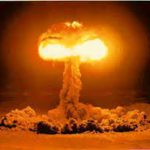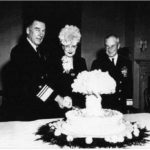 “You are too shallow, Hastings, much too shallow,
“You are too shallow, Hastings, much too shallow,
To sound the bottom of the after-times.”
(K. Henry IV part 2)
Given Obama’s visit to Hiroshima, I am re-publishing this post from last year. (May 2016) I think it is relevant, for the accepted vulgata does not tell the whole story.
(The year 2015 has already featured some momentous anniversaries, the Magna Charta** (Feb 1215), the end of WWII in Europe (May 1945) and the biblically spectacular slaughter of Japanese civilians with the first atom bombs in August 1945.
Given the volume of material, books, articles and documentaries available on the bombing of Hiroshima and Nagasaki, I make no pretense to surprise the readers with anything new. The past is cast, the bombs cannot be unbombed, the survivors healed or the dead resuscitated.
But it is a privilege of history to see the past with the eyes of the present. Besides, history becomes interesting when the present yields insights that brighten the vision of the past. Which explains the continued printing of novel histories about the same foregone and immutable facts.
Furthermore, while we all agree that historians without facts are useless, we also agree that facts without historians are lifeless and meaningless. And history being then a continuous process of interaction between present historians and past facts, it follows that history is an unending dialog between the past and the present.
This self-evident introduction was necessary, I think, because the still prevailing and popular perception of Hiroshima is perfectly conveyed by the headline in one of the dailies of August 1945, “Peace, Our Bomb Clinched It.”
Now, perception is the sovereign mistress of opinion and often akin to faith. Back in time, questioning the faith could bring the questioners to the stake – today they are luckier but still suspect. Besides, in the topic instance, pride, relief, revenge and righteousness all combined to confirm the conviction that “the bomb did it.”
The intent here is not to question the perception, but to follow the evolution of the last few days of the war – to show how the bomb became ‘useful’ to Japan for reasons that may escape a summary observation. And, later, to show how the idea of the bomb evolved and matured in the collective mind, after the first spectacular demonstration.
The index of our historic memories is limited. World War II was indeed global, but it may be overlooked that the Soviet Union was not at war with Japan. In fact a treaty of neutrality, signed in the 1930s linked the two countries. The Japanese counted on the treaty, partly to relieve them from heavily defending Manchuria (North East China), which they occupied in 1931. And partly hoping to employ the Soviets as intermediaries, in the surrender negotiations with the US.
But in November 1943, at the Allies’ Conference in Teheran, Roosevelt and Churchill prompted Stalin to declare war on Japan, as Churchill wrote in his memoirs. Stalin promised he would, three months after victory on Germany. For though, following the defeat at Stalingrad in Feb 1943, Germany began retreating, the war was far from over and the USSR needed all its resources deployed against the Wehrmacht.
Having committed itself to fight Japan, Stalin did not renew the neutrality pact, notwithstanding the prompting, the requests and the concern of the Japanese. Nor he told them why.
The most critical date affecting the events of Japan’s surrender is August 9, 1945, when the Supreme Japanese Council met to discuss, for the first time, unconditional surrender. Earlier on, the Supreme Council viewed an unconditional surrender unthinkable, for they deemed it would lead to a complete uproot of Japanese beliefs, traditions and way of life, as symbolically embodied in the figure of the Emperor.
What changed their mind? Here the timing is important. The Nagasaki bomb exploded after the Supreme Council had already met to discuss the surrender, in the morning of August 9 – the news of the Nagasaki explosion reached them in the afternoon. They had learned of Hiroshima three days before, but a detailed report only reached them on Aug 10. If “the bomb did it”, it seems unexplainable why the Supreme Council waited three days to convene, after Hiroshima on Aug 6.
One notion is that the Japanese knew nothing about nuclear bombs. They actually had a nuclear weapons program but, just as in Germany, it was not pursued as a priority for whatever reasons.
More importantly, the nuclear explosions were indeed devastatingly spectacular, but they did not constitute a quantum leap in destruction, compared with the effects of the US bombing campaign in the summer of 1945. Initially, the US list of destruction included cities with inhabitants ranging from 30,000 to 100,000.
Sixty-eight cities had already been totally or partially destroyed with conventional carpet bombing. In March 1945 the firebombing of Tokyo caused an estimated 120,000 deaths. In the grim statistics of killings, Hiroshima was 4th in number of victims and 17th in percentage of destruction, among the 68 fire-bombed cities.
In this context, the attitude of Japanese authorities is telling. After the March massacre in Tokyo, the Foreign Minister is reported to have said that people would gradually get used to daily bombings, which would strengthen their unity and determination.
And the War Minister, General Korechika Anami (Aug 13), viewed the effects of the atomic bombs no worse than the recurrent fire-bombing, in which the overwhelming numbers of victims were civilians anyway, hence not affecting whatever strength remained in the Japanese army.
Still, on Aug 9, through fate, planning and coincidence, the USSR declared war on Japan, the very day of the Nagasaki atomic bombing. Stalin was actually very punctual, as he had promised his intervention 3 months after victory on Germany (May 9, 1945).
This event dashed Japan’s hopes and strategies to use the USSR as a mediator in the surrender. The strategy being that an unconditional surrender by Japan would strengthen the US against the interests of the Soviet Union along its Eastern shores. Therefore the Soviet Union should have been interested in securing some remaining autonomy for Japan.
But the military strategies were also upset. Manchuria being essentially undefended, the USSR army conquered it in days, followed by the Sakhalin Islands. Next on line was Hokkaido, the Northern island of Japan,. Hokkaido was also not well defended, as the Japanese forces were concentrated on the South, in view of a predicted American invasion.
Quickly, the unthinkable became the only option, unconditional surrender. On hearing of the Soviets’ declaration of war, the Japanese Prime Minister Kantaro Suzuki, is quoted to have said, “The game is ended.” The Soviets were physically in the parlor.
But what about the argument that the bombs saved American lives by rendering a ground invasion unnecessary? Yes, but it should be noted that the invasion was planned for the next November, three months later. All the major cities within range of the Tinian air base had been firebombed. Only six smaller cities between 30,000 and 100,000 people remained to be bombed.
Truman’s famous “rain of ruin” had already fallen in abundance, though leaving the Japan leadership, on the whole, unimpressed. Which leadership, however, was very promptly impressed by discovering the Soviets on the home soil.
The Japanese adopted Brutus’ reasoning after the battle of Philippi,
“Our enemies have beat us to the pit:
It is more worthy to leap in ourselves,
Than tarry till they push us.”(1)
Nevertheless, the atomic bombs, and the subsequent Japanese surrender, while ending the war and stopping the Soviets, also created the opportunity of saving face, especially for the Emperor – saving face being a universal sentiment, but somewhat extreme in Japanese culture, according to experts.
The atom bomb was comparable to a supernatural event. And “a scar nobly got is a good livery of honour.”(2) Blaming the bomb for losing the war, exempted, or at least reduced, the blame of Japan’s leadership for the defeat and for all preceding errors and horrors.
Furthermore, in the eyes of the world, and partially of America, Hiroshima and Nagasaki made Japan the perceived (or rather the actual) victim of a live experiment in mass annihilation. And, as we know, perception is the sovereign mistress of effects. In the instance, victimhood elicited sympathy, with positive reflections in future developments for the country and her people – as witnessed even today.
Still, it wasn’t long before Hiroshima and Nagasaki also extended the questionable magic of the nuclear bombs from the military to the political economy, which is itself the power of domination. Domination that included the morphing of the unspeakable, human-revolting properties of a nuclear device into a commercial promotional tool.
The atom bomb(s) joined the society of the spectacle, in the inevitable company of glamour, music and sex. A “sex-bomb” referred to a transfigured, nuclear superwoman, dropped from heaven to redeem men from their lack of sexual imagination.
Here are the lyrics of one song,
“Got a doll, baby, I love her so
Nothing else like her anywhere you go
Man, she’s anything but calm
A regular pint sized atom bomb
Atom bomb baby, little atom bomb
I want her in my wigwam
She’s just the way I want her to be
A million times hotter than TNT
Atom bomb baby loaded with power
Radioactive as a TV tower
A nuclear fission in her soul
Loves with electronic control.”
 A Miss Atom-Bomb Competition was held from 1952 until 1957.
A Miss Atom-Bomb Competition was held from 1952 until 1957.
The detonations on the Bikini Atoll are remembered for displacing an entire indigenous population of islanders and for inspiring the line of revealing swimwear for women.
More on the military side, the lyrics of another song went,
“A friend of mine in a B-29
Dropped another load for luck,
As he flew away he was heard to say,
A hubba-hubba-hubba, yuk! yuk!”
 And, given the success of the first practical experiments, many in the military were eager to continue. So much so that in the following year, 1946, at the completion of a project of new successful nuclear developments, tests and expansion, an “atomic-cloud cake” was confectioned to celebrate the occasion. The cake in the picture is cut by the general in charge, Admiral Blandy and his gracious wife. The picture was the centerpiece in an issue of the Washington Post.
And, given the success of the first practical experiments, many in the military were eager to continue. So much so that in the following year, 1946, at the completion of a project of new successful nuclear developments, tests and expansion, an “atomic-cloud cake” was confectioned to celebrate the occasion. The cake in the picture is cut by the general in charge, Admiral Blandy and his gracious wife. The picture was the centerpiece in an issue of the Washington Post.
The event, in itself tragi-comical, had unusual consequences. A Unitarian and outspoken minister, Pastor A. P. Davies thundered from his pulpit,
quote
I have with me here in the pulpit this morning a page from a newspaper. From a very fine newspaper. It contains a picture—as it seems to me, an utterly loathsome picture. If I spoke as I feel I would call it obscene. I do not blame the newspaper for printing the picture, or the photographer for taking it. What fills me with bitterness is the fact that such an event could take place at all. It is a picture of two high naval officers and a very beautiful lady. They are in the act of cutting what is called an atom-bomb cake. And it is indeed a cake shaped in the form of an atomic explosion. The caption says it is made of angel food puffs. I do not know how to tell you what I feel about that picture. I only hope to God it is not printed in Russia—to confirm everything the Soviet government is telling the Russian people about how ‘American degenerates’ are able to treat with levity the most cruel, pitiless, revolting instrument of death ever invented by man… The naval officers concerned should apologize to the armed service of which they are a part, and to the American people. No apology would be sufficient to efface what it may mean to the people of the world.
unquote
In the aftermath of Pastor Davies’ tirade many condemned him as ungracious and unpatriotic. However, an influential cartoonist, friend with the Secretary of the Navy, James Forrestal, wrote to him as follows,
“Dear Jim,
The outburst of Reverend A.P. Davies about the atomic bomb cake is, I feel sure, a sign of the times, which I feel should not be ignored.
Public relations officers of both the War and Navy Departments have been out of hand for some time, and I have detected for some months a growing undercurrent of feeling that will affect the whole military establishment if something isn’t done about it.
I have compiled a list of new and terrifying weapons announced by the War and Navy Departments, and of other stories originating there which are boastful or threatening. The total effect was bound to produce a popular reaction, and I really feel that you and Bob Patterson ought to look very seriously into this business.
You are going to have a very hard time with the next Congress getting appropriations, and if the large church-going population of this country with its pacifist leanings gets the idea that the Services are out of hand, it will have a bad effect in the fight for adequate appropriations.
I am sure you appreciate the spirit in which I am writing this.
Yours.
Walter Lippmann
Honorable James V. Forrestal
Secretary of the Navy
Washington 25, D.C.”
Note that, in the letter, the concern is not about the menacing weapons or the disrespect for the victims of the atom bombs, but for the fate of the nuclear-arms-related appropriations. The Secretary of the Navy agreed.
Ironically, the newspaper with the picture of the atomic-bomb cake reached Moscow. The Itzvestia published the picture with the comment, “Soviet newspapers took cognizance today of the recent serving, at an American officers’ club, of a cake shaped like an atom bomb explosion. One of us commented that American “atomists” would like to cook a big atomic kasha and make millions of peaceful people bear the consequences.”
(“kasha” is a popular Russian cereal).
Which makes it almost unavoidable to report a Russian saying, popular after the disaster wrought on the Russian people, following the “color revolution” that dissolved the Soviet Union, “Everything the Soviet Government said about Russia was false, but everything they said about America was true.”
Probably, soon after Hiroshima and Nagasaki, we all would have been “too shallow to sound the bottom of the aftertimes”, to guess what would happen. But, considering that one trillion plus $$ have just been budgeted for the upgrade of the US nuclear arsenal, on land, sky and space, there were plenty of hints.
Or, as Shakespeare would probably say,
“And in these indexes, although small pins
To their subsequent volumes, there is seen
The baby figure of the giant mass
Of things to come at large.”(3)
1. Julius Caesar
2. All’s Well That Ends Well
3. Troilus and Crwessida
** Those interested in the Magna Charta, may wish to watch the Video Historical Sketch I dedicated to the event, as part of the series produced at the TVCTV Studios of Portland Oregon, https://www.youtube.com/watch?v=7ClQwRXwvfY&index=3&list=PL6e-X0PEeMneVYeDxMc3IS2JgQ3ZJtiBG
In the play. Prince John of Lancaster, son of Henry IV puts down Hasting’s remarks about what will or may happen in a confrontation between the forces of King Henry and the rebels.
